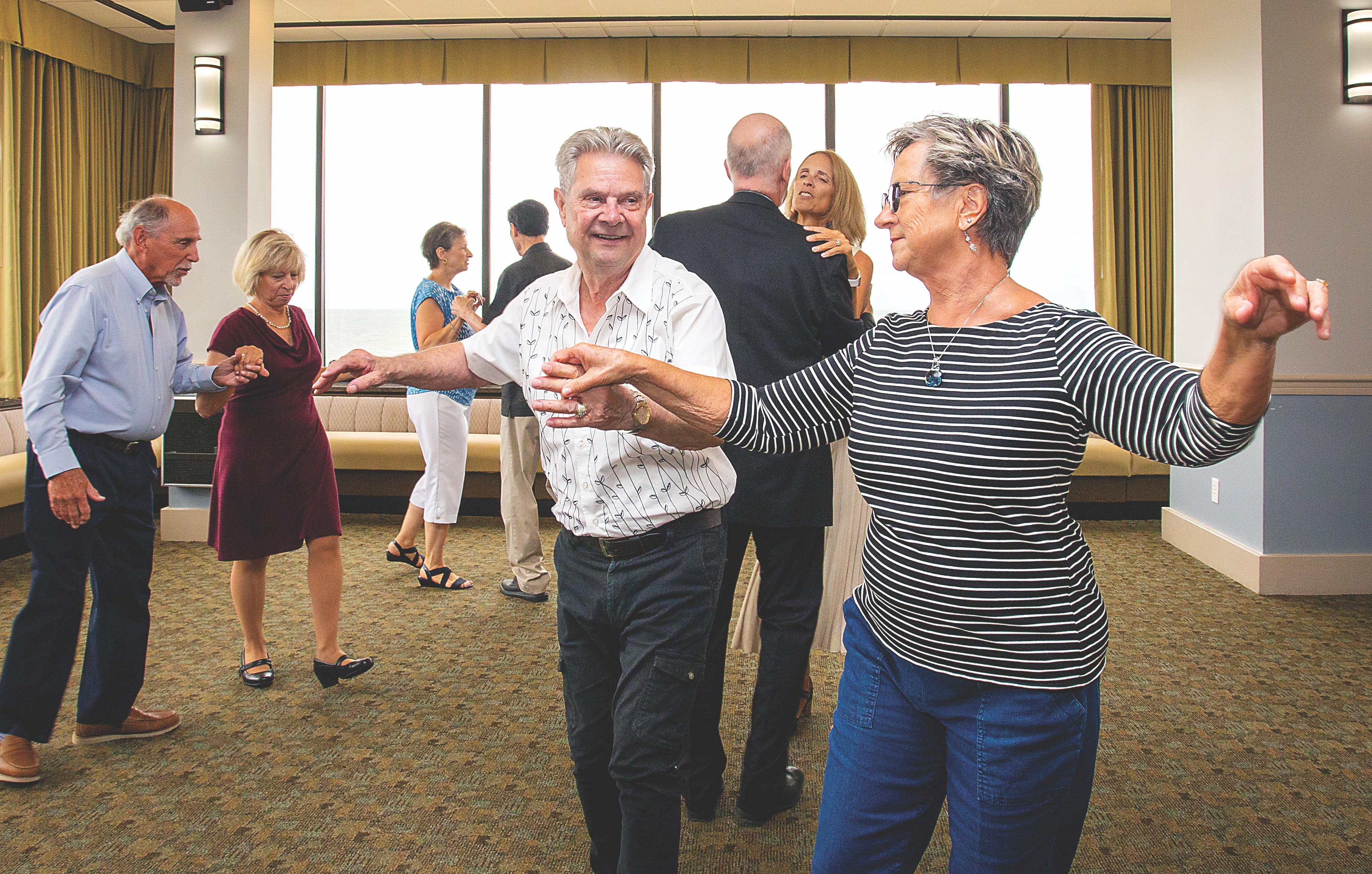
A lifelong dance floor shuffler tries to step up his ballroom game
By Bill Newcott
Photograph by Carolyn Watson
From the Winter 2023 issue

‘We’re gonna go for a stroll on the boardwalk,” says Thom Pemberton, which is a tad confusing as this is a dance class in the basement of the Cape Henlopen Senior Center and we’re a good quarter-mile from the Rehoboth Beach boardwalk.
I squint at him quizzically, and I catch on Pemberton’s face the fleeting realization that he might be dealing with an idiot. He gestures elegantly to the linoleum floor.
“This is our boardwalk, right here,” he reassures me. “And I want us to just, you know, walk in a big circle here as if we were walking along the boardwalk.”
My wife, Carolyn, smiles sweetly.
“He knew that,” she lies.
We link arms and stroll in a wide circle to the sound of Sammy Davis Jr.’s not-at-all annoying “Candy Man,” slowing occasionally to avoid colliding with the four or five other couples here for Pemberton’s regular Thursday morning beginners class. My mind knows those pairs have barely more dance experience than I have; my sinking heart realizes that, compared to me, they are the reincarnation of Fred Astaire and Ginger Rogers.
Pemberton is following us on our imaginary promenade along the boards.
“I want you to think about what you’re doing right now,” he says. “Just walking. You’re already finding the rhythm of the music.”
I want him to continue, saying, “And believe it or not, you’re dancing right now!”
But he doesn’t. Because we’re not. He stops us.
“Now,” he says, “I want you to just dance with each other the way you usually do.”
Well, that’s easy. I take Carolyn in my arms, holding her just a little less tightly than I ordinarily would, my right hand on her waist, the fingers of my left hand folded into hers. I’ve danced this way since my first high school CYO social in the St. Mary’s School gymnasium, clinging to a classmate as a pickup band played the Bee Gees’ “To Love Somebody.”
We sway to the music, the way we have at home virtually every night since COVID-19 struck; ever since the evening Carolyn turned off our TV and declared, “We need to dance every single night.”
The song ends. Carolyn and I step apart.
“Well,” Pemberton sighs, “at least it’s good to see you like the idea of dancing together.”
This is not the first time I’ve taken a stab at the box step. On any number of ocean cruises, flustered dance instructors have talked me through the thing: quick-quick slow … quick-quick slow. Every time, I’d feel like I’d gotten the hang of it, only to later realize I’d forgotten everything, like the details of a passing dream.
The dance move that Pemberton refers to as the American box step works best when someone is playing a rumba, a Cuban-flavored piece written in 4/4 time. For me, “rumba” conjures up songs like “Besame Mucho” or “Whatever Lola Wants” from “Damn Yankees.” So I’m surprised when Pemberton slips a CD into his player — and I immediately recognize the opening riffs of Helen Reddy’s bouncy hit song “Leave Me Alone (Ruby Red Dress),” the one in which Helen repeats the first phrase 43 times.
We tentatively take those first two “quick-quick” steps to the left. (Well, to my left. Everything is reversed for Carolyn, who needs to mirror my every move. I am reminded of Ginger Rogers’ observation that she had to be able to do everything Fred Astaire did — only backwards … and in heels.) Then a slow left-foot step forward followed by a two more quick steps: my right foot diagonally to the right and the left foot over to meet it. Then a slow right foot back to my starting position — and repeat. And repeat. And repeat.
“Don’t look down,” Pemberton cautions. “You’ve got to move your brain from your head to your feet.”
“Leave Me Alone” has a particularly emphatic beat. It’s a perfect choice for first-time box steppers, and soon we’re feeling pretty good about it.
“Mirror ball, here we come!” I’m thinking — until Pemberton brings things to a halt. He stands there for a second, rubbing his right forefinger against his chin.
“Remember when we went strolling on the boardwalk?” he asks. “Remember how we just put one foot in front of the other?”
He demonstrates, and I realize that I am at this moment jealous of the way Pemberton walks. Whereas my perception of walking is to stick one foot out in front of me and, through brute force, employ that leg to haul the rest of my body forward, Pemberton appears to glide weightlessly from foot to foot; his upper body floating along, dipping only slightly with a gentle rhythm, as if he’s hearing some ethereal soundtrack.
“You see?” he smiles. “When we stroll on the boardwalk, we take natural, short steps.
“What we don’t do,” he adds, and I know what comes next is going to be all about me, “is this!”
Now he starts taking enormous strides — sideways, forward, diagonally — that resemble a box step as enacted by Jerry Lewis in his prime. The Ministry of Silly Walks, clearly, has nothing on me. I glance around the room, laughing but a little embarrassed. Happily, no one is paying the slightest bit of attention, but are instead focusing on their own progress. And then I realize: They have all, every one of them, been here.
Helen Reddy’s final “Leave me alone” is fading away. James, a friend of mine who happens to be in the class, approaches me, pulling a wrinkled sheet of paper from his pocket.
“Here,” he says. “I’ve written it all down.”
And sure enough, there in pen and ink is a box-step diagram: arrows and lines, a “q” for each quick step and an “s” for every slow one. It looks almost like a math equation, which makes sense because James is a mathematician. A mathematician who can dance rings around me.
The week between Dance Time With Thom sessions (that’s not what he calls them; I just made that up) are supposed to be spent sharpening the skills you’ve learned during your hour-long lesson. For Carolyn and me, that means spending the ensuing seven days working on that box step each night, seeking out new rumbas that would keep us in line.
We’re getting the hang of it, thanks in part to Andrea Bocelli’s impassioned “Besame Mucho” and, surprisingly, The Beatles’ “Till There Was You.” I do miss hanging all over Carolyn like a fevered adolescent, but I’m happy that we’ve found something new to do together.
We arrive at our second lesson totally stoked to show off our box-step skills. But Thom is throwing us a curve.
“We’ll get to the box step,” he assures us. “But today we’re going to concentrate on the foxtrot.”
We nod dumbly, as if we understand what he’s talking about. All I know is, most of my parents’ old 78 rpm records, from Glenn Miller to Spike Jones, were labeled as foxtrots, which I understood even as a child was some kind of dance step. So pervasive was the foxtrot in the 1930s and ’40s that it virtually rendered every other step, including the tango, the waltz and the Lindy hop, irrelevant.
In fact, when Bill Haley released the seminal rock ’n’ roll hit “Rock Around the Clock” in 1954, the record company took one listen, shrugged its corporate shoulders and labeled it a foxtrot.
Thirty seconds into learning the foxtrot, however, I am yearning for the good old days of the box step. While the closed square of the box step offers the reassuring notion of always returning to your starting point, the relatively irresponsible foxtrot takes the dancers off in a linear motion — two slow steps forward, two quick steps to the side — heading off for who knows where.
“Slow, slow, quick-quick,” says Pemberton as we muddle through a nascent foxtrot. “Slow, slow, quick-quick …”
It’s all well and good, but the basement of the Cape Henlopen Senior Center isn’t all that big, and with growing panic I realize there is a wall steadily approaching. Carolyn is doing her part, following me step for step, backwards. Only I see the impending calamity.
“What am I going to do?” I finally ask Pemberton, who until this moment seems undisturbed that we are about to crash through the wall, into the kitchen area and up the back stairs.
“Well, you need to turn,” he says. (I knew that.) Then, “May I?”
Pemberton slips between Carolyn and me, seamlessly taking my place. With the dexterity of a lynx, he demonstrates how to insert a few deft sidesteps into the trot while gently guiding Carolyn to the left with his right hand.
“You see?” he smiles. Pemberton has one of those smiles that approaches Cheshire Cat breadth, but it’s not nearly as scary.
Carolyn and I dutifully try to duplicate what Pemberton five seconds ago made look so easy. I fear we resemble Indiana Jones and Short Round stepping on fortune cookies.
“You’ll get it!” Pemberton enthuses. “You’ll get it!”
Carolyn and I are sitting across from Pemberton at the Robin Hood Restaurant in Rehoboth Beach. It’s a 55-year-old place where, if everybody doesn’t know your name, they certainly know Thom Pemberton’s.
“They’re newbies,” he informs the server, who apparently seldom sees anyone actually read the menu.
Pemberton has been breakfasting here regularly since 1991, when he moved to Rehoboth full time after a career running telephone-based information systems for the Baltimore Sun and Washington Post. He first hooked up with a beach publication called The Summer Yellow Pages (which later became Beach-Net.com), then for
15 years served as music director at Epworth United Methodist Church.
But long before any of that, he was a dancer.
“I’ve always danced,” he says. “I started as a kid, but I never had a formal education in it. When I was in sixth grade, we had a talent show, and I did the Charleston.”
As you might expect, there was parental inspiration involved.
“My mother, who was a good dancer, made up games for my sister and me,” Pemberton recalls. “She’d wash the kitchen floor, lay out two towels, and then give us a dance class while we were drying. And we’d do it all over again on the hardwood floors.”
In other words, Pemberton’s mother was a latter-day Tom Sawyer with a dash of Mary Poppins.
Pemberton was in his 20s, working as a department store buyer, when a friend told him about a Fred Astaire Dance Studio opening in Towson, Md.
“You know how to dance,” the friend said. “Let’s give teaching a shot.”
Within a year, the pair had bought the place. Pretty soon they had raised the studio’s game to the point where it was a recognized training ground for competitive dancers — and Pemberton himself was competing worldwide: Germany, the Netherlands, Spain, Colombia, London and Tokyo for starters.
“I can’t say I won a lot,” he says with a sheepish grin. “Because I’m so short. My lines are not long; the taller dancer can really stretch those lines.”
So far, spinning his life story over a cup of Robin Hood’s remarkably hearty vegetable soup, Pemberton hasn’t thrown me a lot of narrative curveballs. And then I ask him what he did after his ministry at Epworth.
“Oh, well,” he says, putting down his napkin. “I had some health issues.”
Which, it turns out, is like Louis XVI saying, “I’ve got a sore throat.”
It was just over 13 years ago, while working at Epworth, that Pemberton was diagnosed with stage 4 pancreatic cancer.
“I was given six months to a year,” he says. “Technically, it was inoperable, but they decided to take a chance. And things went well.”
The surgery was anything but routine. And today, Thom Pemberton — who teaches ungifted seniors how to foxtrot; who glides along the dance floor as if riding an invisible hoverboard — is a man with no abdominal wall.
It’s a painfully personal story, but one that Pemberton, who now serves as co-music director at Metropolitan Community Church in Rehoboth Beach, tells enthusiastically.
“I’ve been blessed with healing,” he says. “My mission, if you will, is to share that message of hope with everyone I can.”
He leans back in our booth and places both hands flat on the table.
“So,” he says, “you are sitting here today with a miracle man.”
It is not much less of a miracle that, by week 3, Pemberton has Carolyn and me doing a clumsy foxtrot that does not involve head-on collisions with our classmates. For reasons known only to him, he seems to feel we’re ready to work on some style points.
“The rule for ballroom dancing,” he says, “is ‘nose over toes.’ If I’m going to go to the right, I’ve got to turn my head in that same direction.
“After all, we’d never walk along the boardwalk doing this” — and he proceeds to stroll forward while staring to his left. I resist telling him I actually do just that, on the lookout for dolphins, kites and, generally, shiny objects.
In any case, I fear Pemberton has overestimated our readiness: In a moment or two we are trapped in a corner, bouncing like a confused Roomba. He quickly intervenes.
“I’ve got to get you out of this corner,” he affirms solemnly, sizing up our predicament with a trace of his perpetually patient smile. “We can’t do a walk-walk-side because we’d crash. So we’re gonna rock-rock, then sidestep together.”
Guiding us with his hands, Pemberton helps us substitute a pair of rocking motions for the usual two steps. That way, we’ll go no closer to the wall, and the two quick sidesteps — with me gently using my right hand to swing Carolyn to the left — will lead us out of trouble.
“You may have to do it twice,” he says, “but at least you’ll be out of the corner, and you can go back to the regular step.”
Which will, I tell myself, inevitably lead us into another corner. Pemberton seems to sense my frustration.
“Hey,” he says. “Let’s just put on some more music and see how it goes.”
“Who knows what the fates/ have in store?” sings Frank Sinatra. It’s the foxtrot standard, “Something’s Gotta Give,” an appropriate sentiment when it comes to me and ballroom dancing, especially when Ol’ Blue Eyes gets to the part that goes, “When an irresistible force such as you/ meets an old immovable object like me …”
By the end of the hour, Carolyn and I are no longer jamming ourselves into the corners. Mercifully, Pemberton allows us to end the lesson squaring off in a rumba. Home at last, I think.
Over the ensuing two lessons, Thom Pemberton strives mightily to unleash my inner Arthur Murray, only to find, time after time, Arthur the Aardvark, ever positive, always gamely giving it a go, but somehow inadequate when it comes to processing what are, in reality, ridiculously simple instructions. I feel bad for Carolyn — long, lovely and athletic — who, in the arms of just about any other man on that floor, would by now be gliding across the room like a Disney princess.
Still, we feel pretty good about our rumba box step. We never look at our feet, we keep our noses above our toes-es, and we execute a very cool twirl that Pemberton taught us. We’ve got a community holiday party coming up, and while we certainly won’t be turning any heads on the dance floor, we’ll have fun doing something beyond the middle school two-step.
And at night, after turning off the TV, Carolyn still finds a song for us. Whatever it is, we’ll assume ballroom position and try to shoehorn it into a rumba.
Failing that, we fall into each other’s arms and shuffle, like we did before Thom Pemberton tried to save us — so close that, 55 years ago, Sister Maria Claire would certainly have stormed onto the gymnasium floor and pushed us apart.



